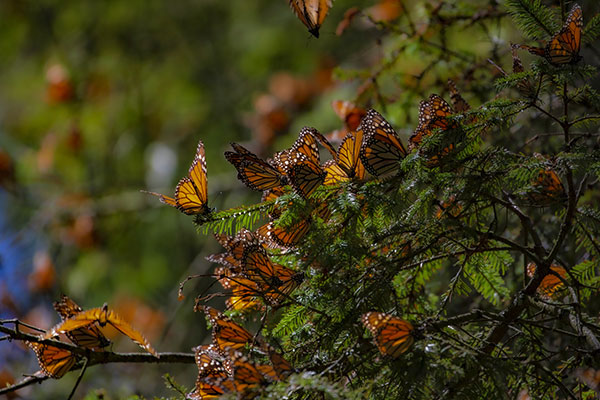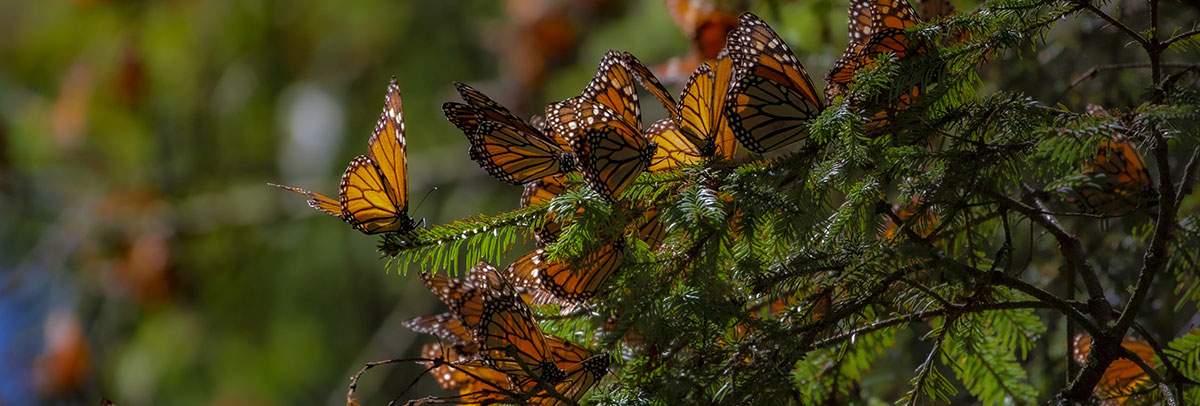Monarch Butterflies and Their Connections
Labor Day may be the unofficial end of summer, but September brings changes in our natural world as well. As the air (hopefully) turns cooler, there is a breathtaking natural wonder that unfolds every year: the monarch butterfly migration. Coincidentally, this event aligns with another important celebration – Hispanic Heritage Month.
The Monarch Butterfly Migration
The monarch butterfly (Danaus plexippus) is known for its vibrant orange and black wings as adults and distinct yellow, black, and white stripped caterpillars. But what makes these butterflies truly remarkable is their journey. Monarchs embark on one of the longest insect migrations on the planet, traveling thousands of miles from United States and Canada to Mexico and back.

By Ginger Werp. Ginger is a KC WildLands Program Coordinator
Here’s how it works:
- In late summer and early fall, the first generation of monarchs, often referred to as the super generation, emerges from their chrysalides in the northern United States and southern Canada. These butterflies are destined to migrate.
- They begin on a southward journey, using a combination of environmental cues and an innate sense of direction to navigate. Monarchs are known to utilize the position of the sun and Earth’s magnetic field to find their way.
- Along the way, they make crucial pit stops to refuel on nectar from various flowering plants. These stops are essential to provide them with the energy needed for the long journey.
- The first-generation monarchs eventually reach their overwintering grounds in Mexico or California, where they gather in dense clusters on trees called oyamel firs. Here, they enter a state of dormancy until spring.
- As temperatures warm in the spring, these butterflies become active again, mate, and then start the journey north. They lay eggs along the way, and their offspring continue the migration.
- This process continues for several generations, with each successive generation moving farther north until the final generation, the super generation, makes the long trip back to the northern breeding grounds.


What does the monarch butterfly migration have to do with Hispanic Heritage Month? The connection lies in the cultural significance of these butterflies in Mexico.
- In Mexico, the arrival of monarch butterflies coincides with the Day of the Dead (Dia de los Muertos), a traditional Mexican holiday that honors deceased loved ones. The indigenous people of Mexico, including the Aztecs and the Purepecha, believed that monarch butterflies were the souls of their ancestors returning for the annual celebration.
- Butterflies, in general, hold a special place in Mexican culture, symbolizing transformation and renewal. They are often seen as messengers between the living and the deceased, carrying the spirits of loved ones to the afterlife.
- The cultural significance of monarch butterflies in Mexico has also played a role in their conservation. Efforts to protect the monarchs and their wintering grounds have gained momentum due to their importance in Mexican heritage.
Celebrating Hispanic Heritage Month
Hispanic Heritage Month, which runs from September 15th to October 15th, offers an opportunity to celebrate the rich cultural contributions of Hispanic and Latinx communities in the United States and around the world. It is a time to recognize the diversity, history, and traditions of these communities.
There are many events in Kansas City during Hispanic Heritage Month that celebrate the diverse cultures and highlight the contributions of Hispanic peoples and their descendants. Here is a list of family friendly, cultural, educational, and community engagement events to get you started. Supporting Hispanic owned business is also a great way to commemorate the month. The Hispanic Chamber of Commerce of Greater Kansas City has a member directory and there are many more in the area to choose.
Conserving Monarch Butterflies and all of the Other Amazing Pollinators
The most important action you can take to help monarchs make this impressive journey is to plant fall blooming native flowers in your yard. Milkweed is also an important native plant to include in your garden to feed monarch caterpillars. Several of the websites listed below have resources to help you get started. Deep Roots has a list of partner native plant sales in the Kansas City area, and Grow Native is rich with resources.
Want the chance to see Monarch butterflies in their native habitats and help in their conservation? Sign up to volunteer with Kansas City WildLands seed collecting or restoring habitats. See all of Bridging The Gap’s volunteer opportunities here.
Get Involved and Learn More
Visit the Pollinator Prairie and attend their event, Hasta Luego Monarchs!
Just outside of the Kansas City metro in Lawrence, KS is Monarch Watch, and organization dedicated to research, education, and conservation of the monarch butterfly. Monarch watch holds several events throughout the year, including Monarch Watch Fall Open House and Monarch Tagging Event.
Learn more about monarch conservation efforts at Monarch Joint Venture and Journey North.
Learn more about Michoacán and Monarchs in Mexican Culture.
Read more about monarch overwintering sites at Monarch Butterfly Biosphere Reserve, and some of the conservationists doing important work of protecting and conserving the species and their habitat. Including men who have lost their lives in their pursuits (article) and a forest geneticist studying the oyamel.
A splendid, interactive article by The New Yorker.






